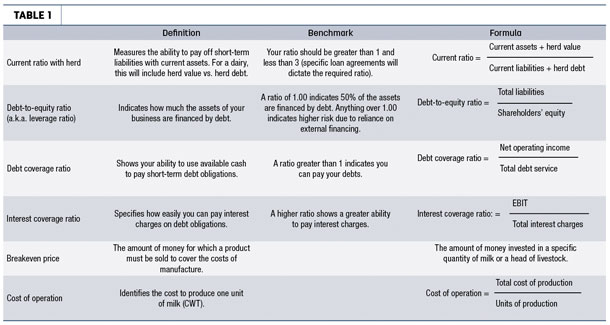The first dash-mounted fuel gauge was introduced in 1914 by Studebaker. Today, we wouldn’t purchase a vehicle without this primary performance indicator of our vehicle’s ability to deliver us to our destination.
We also would not consider a vehicle that did not have other primary and secondary performance indicators of operating efficiency, safety and comfort, such as the speedometer, engine temperature, battery charge and oil life. These indicators provide us with critical information about our vehicle’s operating condition, confidence we will be able to get where we want to be and alert us to potentially dangerous situations before they become too serious.
A financial dashboard for your dairy operation is meant to function the same way as the performance indicators in your vehicle. There are primary performance indicators (PPIs) critical to determining the health of your dairy that give you the snapshot you need to operate smoothly and identify problem areas before they become too pervasive and expensive to fix.
Also there are secondary performance indicators (SPIs) that, when used with PPIs, are helpful for gaining a deeper and more detailed understanding of the health of your operation.
Below you will find recommendations for both PPIs and SPIs that should be considered when developing your financial dashboard. Furthermore, a brief argument for monitoring your dashboard on at least a monthly basis will be presented.
Regardless of your current financial dashboard situation, please consider carefully reviewing your PPI and SPI mix to ensure you have the proper information to operate efficiently and profitably.
Primary performance indicators
Although each dairy operation has unique inputs, PPIs every dairy should be watching include current ratio, debt-to-equity ratio, debt coverage ratio, interest coverage ratio, breakeven price and cost of operation. Table 1 outlines these PPIs, their definition, benchmarks and respective formulas.
Click here or on the image above to view it at full size in a new window.
Your accountant will be able to offer much greater detail and analysis of these indicators and help you optimize their use in your operation.
Secondary performance indicators
Although these indicators are considered to be secondary in importance, they are important to have access to and a working knowledge of to help resolve issues faster and to fine-tune your operating strategy.
The recommended SPIs include cost of labor and feed cost on a per-hundredweight basis, number of cows per employee (this becomes more critical during times of recession and decreased employment), return on investment, return on assets, feed margin and annual comparisons of current and non-current assets, current and long-term liabilities, and equity.
Monitoring frequency
Bob Parsons, the founder of GoDaddy, said, “Measure everything of significance. Anything that is measured and watched improves.” You have so much to focus on day-to-day, and there are so many indicators you could use to monitor your dairy, it is very easy to become overwhelmed and lose focus of the critical financial picture.
The more proactive you are at monitoring your PPIs and SPIs, the better your dairy will operate. However, quarterly monitoring is not enough to affect significant change or to catch potential issues before they become real problems.
How often you monitor your financial dashboard depends on how often the input data is available or enters your system. For example, milk checks are typically cut each month. As this is a critical measurement for your dairy, and it occurs monthly, it is recommended you input your other data and monitor your financial dashboard summary monthly.
However, this may not work for some dairy operations, or you may want more frequent insight into your operations. Customize your dashboard and make it work for you. If you need to monitor your interest coverage ratio more frequently due to an upcoming purchase or operational difficulty, do so. The dashboard is supposed to make your job easier, less stressful and more efficient. However, if you are not monitoring your dashboard at least once a month, please begin to do so.
Summary
There is no adviser who can know your dairy operation better than you do. Please consider having a conversation with your accountant to discuss exactly which indicators you should use in your operation. Ultimately, you operate your dairy for financial safety and security.
It is imperative you monitor your dairy indicators on a regular basis too so you will understand exactly where you can improve performance and cut costs. ![]()
Brady is a CPA and certified valuation analyst and a partner at Cooper Norman. Fetzer recently joined Cooper Norman and brings unique skills to the team as a Juris Doctorate and MBA.








